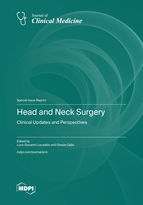Head and Neck Surgery: Clinical Updates and Perspectives
A special issue of Journal of Clinical Medicine (ISSN 2077-0383). This special issue belongs to the section "Otolaryngology".
Deadline for manuscript submissions: closed (20 July 2023) | Viewed by 27374
Special Issue Editors
Interests: otorhinolaryngology; head and neck surgery; rhinology; skull base surgery
Interests: head & neck cancer; surgery; clinical oncology
Special Issues, Collections and Topics in MDPI journals
Special Issue Information
Dear Colleagues,
The field of head and neck surgery has notably expanded in the last several decades, and the technological advancement of open, microscopic, endoscopic, and robotic techniques has allowed us to achieve unprecedented progress. As we are continuously refining our therapeutic approaches to head and neck disorders, the well-known risk of impairing or even permanently damaging critical structures (nerves, vessels, etc.) and functions (swallowing, voice, sense of smell and taste, etc.) is always present.
Therefore, a comprehensive view on the most recent and cutting-edge strategies in this surgical specialty is of paramount importance. In this Special Issue of the Journal of Clinical Medicine, we invite you to submit your scientific contributions to this field in the form of original research articles, state-of-the-art or systematic reviews, or meta-analyses. Examples of such research include the management of head and neck postoperative infections or fistulas; severe (facial, spinal accessory, recurrent laryngeal, etc.) nerve dysfunction of septal perforations; laryngeal scars or granulomas; and orbital or intradural complications after skull base surgery. Papers reporting the clinical results of innovative head and neck surgical techniques with a particular emphasis on the postoperative functional consequences will be welcomed, as well as practical and evidence-based methods for the surgical treatment of a particular head or neck condition. We are looking forward to receiving your manuscripts.
Dr. Luca Giovanni Locatello
Prof. Dr. Oreste Gallo
Guest Editors
Manuscript Submission Information
Manuscripts should be submitted online at www.mdpi.com by registering and logging in to this website. Once you are registered, click here to go to the submission form. Manuscripts can be submitted until the deadline. All submissions that pass pre-check are peer-reviewed. Accepted papers will be published continuously in the journal (as soon as accepted) and will be listed together on the special issue website. Research articles, review articles as well as short communications are invited. For planned papers, a title and short abstract (about 100 words) can be sent to the Editorial Office for announcement on this website.
Submitted manuscripts should not have been published previously, nor be under consideration for publication elsewhere (except conference proceedings papers). All manuscripts are thoroughly refereed through a single-blind peer-review process. A guide for authors and other relevant information for submission of manuscripts is available on the Instructions for Authors page. Journal of Clinical Medicine is an international peer-reviewed open access semimonthly journal published by MDPI.
Please visit the Instructions for Authors page before submitting a manuscript. The Article Processing Charge (APC) for publication in this open access journal is 2600 CHF (Swiss Francs). Submitted papers should be well formatted and use good English. Authors may use MDPI's English editing service prior to publication or during author revisions.
Keywords
- head and neck surgery
- otorhinolaryngology
- postoperative complications
- laryngeal surgery
- endoscopic surgery
- salivary gland surgery
- ear surgery
- surgery of the oral cavity
- sinonasal surgery








